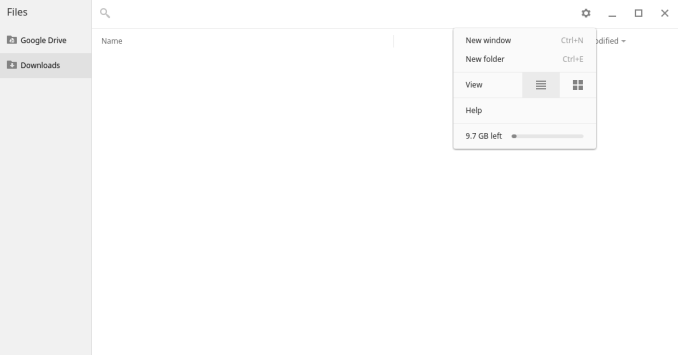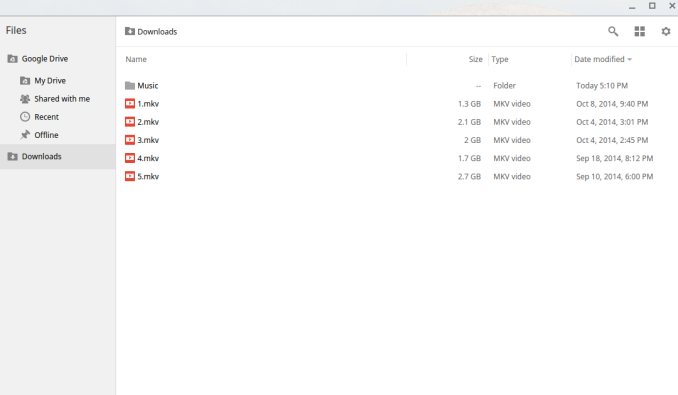Upgrading the SSD in Chromebook & MyDigitalSSD Super Boot Drive M.2 2242 SSD Review
by Kristian Vättö on October 21, 2014 8:00 AM ESTManaging Storage in Chrome OS
Chrome OS behaves a lot like iOS and Android when it comes to file management. While other computer-level operating systems like Windows and OS X give the user full access to system files, Chrome OS only provides very basic file management options.
The user access is limited to 'Google Drive' and 'Downloads' folders, and out of these two Downloads is the only truly local folder since Google Drive relies on cloud storage (although it does have offline functionality too). There is no way to create additional folders (or at least I could not find a way), so if you want to store something locally, it must be stored in the Downloads folder.
The 16GB SSD has about 9.7GB left with the operating system installed, so there is certainly not much room for offline storage in the default configuration. With the 256GB SSD installed, the free space increases to about 204GB, although I am not sure where the remaining ~46GB has gone.
Fortunately, it is possible to create folders inside the Downloads folder, so you can at least have some level of organization for local files. Chrome OS has integrated audio and video playback software (even MKV files are supported!) that can be used to play back local files, but especially the audio player is very limited and does not have support for playlists or other more sophisticated features. It works, but the user experience is much better if you have an Internet connection and use Google's web-based Play Music.
Anyway, there is not much to say about Chrome OS' file management. It is very limited and not user friendly for someone who is used to using Windows or OS X, but if you can work around the limitations it can be usable even with a larger internal drive. As far as performance testing under Chrome OS, there isn't much to be done; the MyDigitalSSD Super Boot Drive feels a bit faster on some tasks, but Chrome OS doesn't tend to hit storage much so the performance benefits aren't the primary reason to upgrade. But let's look at performance with the original and upgrade SSDs using our standard storage tests.












67 Comments
View All Comments
hojnikb - Tuesday, October 21, 2014 - link
Given the space constraints of the 2242, wouldn't make more sense to go with something like sandforce ?This is already designed with dramless in mind, so it would perform better. And at this point, these old controllers must be dirt cheap.
Also one more thing. Given how many cheap laptops use eMMC instead of real ssds, would it be possible to test that aswell ? As i'm aware, eMMC solutions are usually not that fast, but i do wonder how slow they really are.
III-V - Thursday, October 23, 2014 - link
eMMC 5.0 should be very fast, and should be surfacing in devices this year.noelbonner - Tuesday, November 11, 2014 - link
I'd go for one of the top laptops on the market instead (like the rankings at http://tinyurl.com/msegfz9 for example).duploxxx - Tuesday, October 21, 2014 - link
Anandtech quote:While the whole netbook boom kind of died with the introduction of tablets, Chromebooks have been gaining more and more traction recently. The original Windows netbooks failed to provide a smooth user experience due to the lack of operating system optimization, and Windows was simply way too heavy to be run with such limited resources
requires a BIG correction, AMD Brazos was and still is more then fine to run these netbook designs, a 7.2k or better SSD HD gives a very good daily usage of that device. It are the horrible ATOM all over the world thx to Intel and OEM designs that screwed the netbook usecases......
just like first generation ATOM for tablet is useless and made th windows tablet flop.
lilmoe - Tuesday, October 21, 2014 - link
Exactly. Hardware played a larger role in the failure of netbooks. It was simply too slow, and low power processors weren't "there" yet.Microsoft should make a huge comeback with Windows 10 in netbook form factor. Interesting will be the price and capabilities of these devices. Good performing $150-$250 Windows 10 netbooks will eat Chromebooks' lunch and make it seem they never really existed.
titaniumalloy - Tuesday, October 21, 2014 - link
I think the biggest problem is that they had stupid slow 320GB HDD. If they had used 16GB SSD, the machines would have been good. Of course, SSD were pricey 4 years ago. I believe if Microsoft come back into the netbook arena, they would perform well. Microsoft is usually way to ahead of its time or too far behind.hojnikb - Tuesday, October 21, 2014 - link
Dont forget. Very first netbooks were fitted with ssds (very small ones though).andrewaggb - Tuesday, October 21, 2014 - link
I owned 2 netbooks, one with an atom processor and a 1024x600 res screen, one with an amd c50 and 1280x720 screen.I hated them both. The keyboards were small and cramped, the screen resolution on both needed to be 768 minimum height. The hard disks were painfully slow, it took forever to get anything loaded. The amd c50 cpu was awful. It was cpu bound by all sorts of things and not nearly enough applications were gpu accelerated.
Personally, I think the 11-13" laptop range is a much better size, with at least a 1366x768 resolution and an ssd. We have those today, but not for $200.
I'd definitely rather have windows than a chromebook, but microsoft needs to get their windows updates streamlined and smaller...
jabber - Wednesday, October 22, 2014 - link
I've tried some of the new ultra cheap Windows 8.1 laptops with AMD E1 CPUs etc. and they are terrible. The CPU is so underpowered it runs at 100% the whole time. Poor HDD performance etc. Miserable experience. The problem is these are the new cheap laptops folks are buying. Makes you really appreciate a lowly Athlon or Celeron CPU, at least they worked. In comparison a Chromebook works far better for the average Joe.abianand - Thursday, October 23, 2014 - link
Let us hope the laptop manufacturers stop pairing Windows 8.1 only with slow CPUs.Richland and Kaveri have many design wins and have many (I say many, keeping in mind I'm talking about AMD CPUs here) laptops in the US market but not in many other countries.